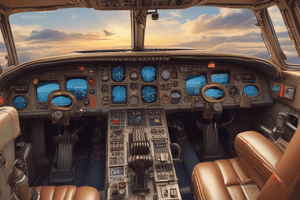Podcast
Questions and Answers
What is the primary purpose of the Federal Aviation Administration (FAA)?
What is the primary purpose of the Federal Aviation Administration (FAA)?
- To promote aviation tourism globally.
- To regulate and oversee aviation safety. (correct)
- To develop new aircraft designs.
- To investigate aviation accidents.
Which aircraft type is classified as lighter-than-air?
Which aircraft type is classified as lighter-than-air?
- Airships (correct)
- Drones
- Helicopters
- Airplanes
What advancement in aviation technologies focuses on reducing carbon footprints?
What advancement in aviation technologies focuses on reducing carbon footprints?
- Propulsion systems
- Sustainable aviation (correct)
- Navigation techniques
- Avionics
Which event marked the first powered flight in aviation history?
Which event marked the first powered flight in aviation history?
What key concept involves the study of air behavior around solid objects like aircraft?
What key concept involves the study of air behavior around solid objects like aircraft?
Which organization is responsible for investigating aviation accidents in the U.S.?
Which organization is responsible for investigating aviation accidents in the U.S.?
What type of aircraft is included in the rotary-wing category?
What type of aircraft is included in the rotary-wing category?
Which aspect of aviation primarily deals with determining an aircraft's position?
Which aspect of aviation primarily deals with determining an aircraft's position?
Flashcards
Aviation
Aviation
The design, development, operation, and use of aircraft.
Fixed-wing Aircraft
Fixed-wing Aircraft
Aircraft that generate lift using wings, like airplanes and gliders.
Aerodynamics
Aerodynamics
The study of air's interaction with objects, crucial for aircraft design.
Propulsion in Aviation
Propulsion in Aviation
Signup and view all the flashcards
Aviation Regulation Bodies
Aviation Regulation Bodies
Signup and view all the flashcards
Pilot Licenses
Pilot Licenses
Signup and view all the flashcards
Aviation Safety Protocols
Aviation Safety Protocols
Signup and view all the flashcards
Urban Air Mobility
Urban Air Mobility
Signup and view all the flashcards
Study Notes
Basic Concepts of Aviation
- Definition: The design, development, operation, and use of aircraft.
- Types of Aircraft:
- Fixed-Wing: Airplanes, gliders.
- Rotary-Wing: Helicopters, drones.
- Lighter-Than-Air: Balloons, airships.
History of Aviation
-
Early Flight Attempts:
- Icarus Myth: Ancient dreams of flight.
- Leonardo da Vinci: Early designs for flying machines.
-
Pioneering Flights:
- Wright Brothers (1903): First powered flight with the Wright Flyer.
- Charles Lindbergh (1927): First solo transatlantic flight.
Key Components of Aviation
- Aerodynamics: Study of the behavior of air as it interacts with solid objects (aircraft).
- Propulsion: Methods to generate thrust; includes jet engines and propellers.
- Navigation: Techniques to determine an aircraft's position, including GPS and traditional methods.
Aviation Regulations
-
Regulatory Bodies:
- Federal Aviation Administration (FAA) in the U.S.
- International Civil Aviation Organization (ICAO) globally.
-
Licensing:
- Pilot licenses: Private, commercial, and airline transport pilot licenses.
- Aircraft certifications: Airworthiness and operational approvals.
Aviation Safety
- Safety Protocols: Standard operating procedures (SOPs), maintenance checks, crew training.
- Accident Investigation: National Transportation Safety Board (NTSB) in the U.S. investigates incidents and accidents.
Modern Developments
-
Technology Advancements:
- Avionics: Electronic systems used in aircraft for navigation, communication, and monitoring.
- Sustainable Aviation: Research into biofuels, electric aircraft, and regenerative technologies to reduce carbon footprints.
-
Commercial Aviation:
- Major airlines and their fleets, routes, and hubs.
- Impact of COVID-19 on the aviation industry.
Economic Impact
- Global Economy: Aviation as a key driver of global trade and tourism.
- Employment: Jobs in piloting, maintenance, flight operations, and airport management.
Future of Aviation
- Urban Air Mobility: Rise of air taxis and eVTOL (electric vertical takeoff and landing) aircraft.
- Space Aviation: Commercial space travel and suborbital flights becoming more prevalent.
Basic Concepts of Aviation
- Aviation encompasses the design, development, operation, and use of aircraft.
- Aircraft are classified as fixed-wing, rotary-wing, or lighter-than-air.
- Fixed-wing aircraft include airplanes and gliders.
- Rotary-wing aircraft include helicopters and drones.
- Lighter-than-air aircraft include balloons and airships.
History of Aviation
- The myth of Icarus embodies humanity's ancient dreams of flight.
- Leonardo da Vinci's sketches illustrate early designs for flying machines.
- The Wright brothers are credited with the first successful powered flight in 1903 with their Wright Flyer.
- Charles Lindbergh made history in 1927 with the first solo transatlantic flight.
Key Components of Aviation
- Aerodynamics is the study of air's behavior as it interacts with aircraft.
- Propulsion refers to generating thrust through various methods like jet engines and propellers.
- Navigation involves determining an aircraft's position using technologies like GPS and traditional techniques.
Aviation Regulations
- Regulatory bodies like the FAA (U.S.) and ICAO (global) govern aviation safety and operations.
- Pilot licensing ensures competence, with categories like private, commercial, and airline transport pilot licenses.
- Aircraft certifications guarantee safety and operational compliance.
Aviation Safety
- Standard operating procedures (SOPs), thorough maintenance checks, and rigorous crew training are crucial safety protocols.
- The National Transportation Safety Board (NTSB) in the U.S. investigates aviation incidents and accidents.
Modern Developments
- Avionics refers to the electronic systems used for navigation, communication, and monitoring in aircraft.
- Sustainable Aviation focuses on reducing aviation's carbon footprint through research into biofuels, electric aircraft, and regenerative technologies.
- Major airlines play a vital role in global air travel, with fleets, routes, and hubs shaping the industry.
- The COVID-19 pandemic had a significant impact on the aviation industry.
Economic Impact
- Aviation significantly impacts global trade and tourism, serving as a key economic driver.
- The industry generates a wide range of employment opportunities across piloting, maintenance, flight operations, and airport management.
Future of Aviation
- Urban Air Mobility is rising, with air taxis and eVTOL (electric vertical takeoff and landing) aircraft transforming urban transportation.
- Commercial space travel and suborbital flights are becoming more prevalent, pushing the boundaries of aviation and space exploration.
Studying That Suits You
Use AI to generate personalized quizzes and flashcards to suit your learning preferences.




